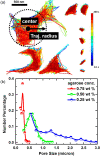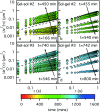Microrheology for biomaterial design
- PMID: 33415310
- PMCID: PMC7775114
- DOI: 10.1063/5.0013707
Microrheology for biomaterial design
Abstract
Microrheology analyzes the microscopic behavior of complex materials by measuring the diffusion and transport of embedded particle probes. This experimental method can provide valuable insight into the design of biomaterials with the ability to connect material properties and biological responses to polymer-scale dynamics and interactions. In this review, we discuss how microrheology can be harnessed as a characterization method complementary to standard techniques in biomaterial design. We begin by introducing the core principles and instruments used to perform microrheology. We then review previous studies that incorporate microrheology in their design process and highlight biomedical applications that have been supported by this approach. Overall, this review provides rationale and practical guidance for the utilization of microrheological analysis to engineer novel biomaterials.
© Author(s).
Figures





Similar articles
-
Passive and Active Microrheology for Biomedical Systems.Front Bioeng Biotechnol. 2022 Jul 5;10:916354. doi: 10.3389/fbioe.2022.916354. eCollection 2022. Front Bioeng Biotechnol. 2022. PMID: 35866030 Free PMC article. Review.
-
Two-point particle tracking microrheology of nematic complex fluids.Soft Matter. 2016 Jun 29;12(26):5758-79. doi: 10.1039/c6sm00769d. Soft Matter. 2016. PMID: 27270816 Free PMC article.
-
Small Volume Microrheology to Evaluate Viscoelastic Properties of Nucleic Acid-Based Supra-Assemblies.Methods Mol Biol. 2023;2709:179-189. doi: 10.1007/978-1-0716-3417-2_11. Methods Mol Biol. 2023. PMID: 37572280 Free PMC article.
-
Particle-tracking microrheology of living cells: principles and applications.Annu Rev Biophys. 2009;38:301-26. doi: 10.1146/annurev.biophys.050708.133724. Annu Rev Biophys. 2009. PMID: 19416071 Review.
-
Particle-Based Microrheology As a Tool for Characterizing Protein-Based Materials.ACS Biomater Sci Eng. 2022 Jul 11;8(7):2747-2763. doi: 10.1021/acsbiomaterials.2c00035. Epub 2022 Jun 9. ACS Biomater Sci Eng. 2022. PMID: 35678203 Review.
Cited by
-
Viscoelastic differences between isolated and live MCF7 cancer cell nuclei resolved with AFM microrheology.J R Soc Interface. 2025 Jun;22(227):20240885. doi: 10.1098/rsif.2024.0885. Epub 2025 Jun 18. J R Soc Interface. 2025. PMID: 40527475 Free PMC article.
-
Influenza A virus diffusion through mucus gel networks.Commun Biol. 2022 Mar 22;5(1):249. doi: 10.1038/s42003-022-03204-3. Commun Biol. 2022. PMID: 35318436 Free PMC article.
-
ATP-induced reconfiguration of the micro-viscoelasticity of cardiac and skeletal myosin solutions.Appl Phys Lett. 2024 Oct 21;125(17):173702. doi: 10.1063/5.0224003. Appl Phys Lett. 2024. PMID: 39444380 Free PMC article.
-
Rapid in situ forming PEG hydrogels for mucosal drug delivery.bioRxiv [Preprint]. 2024 Aug 19:2024.08.16.608319. doi: 10.1101/2024.08.16.608319. bioRxiv. 2024. Update in: Biomater Sci. 2025 Aug 5;13(16):4390-4399. doi: 10.1039/d4bm01101e. PMID: 39229247 Free PMC article. Updated. Preprint.
-
Synthetic mucus biomaterials for antimicrobial peptide delivery.J Biomed Mater Res A. 2023 Oct;111(10):1616-1626. doi: 10.1002/jbm.a.37559. Epub 2023 May 18. J Biomed Mater Res A. 2023. PMID: 37199137 Free PMC article.
References
-
- Chen D. T. N., Wen Q., Janmey P. A., Crocker J. C., and Yodh A. G., Annu. Rev. Condens. Matter Phys. 1, 301 (2010).10.1146/annurev-conmatphys-070909-104120 - DOI
Publication types
LinkOut - more resources
Full Text Sources

